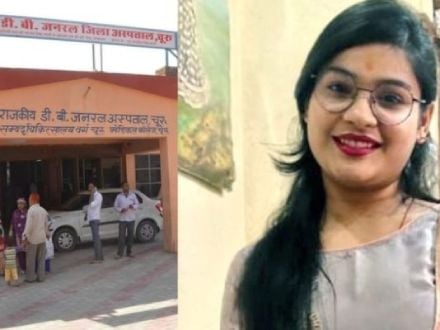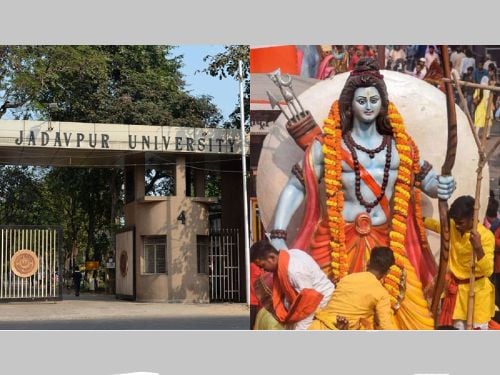By J.G. Arora
[email protected]

Ram setu picture by NASA
Religion is a matter of faith. And for Hindus, Ram Setu is the ancient-most and sacred symbol of their faith, heritage and history. Considering the Congress-led UPA government’s apathy towards Hindu sentiments over Ram Setu,only a peaceful and nation-wide mass movement launched by social, political and religious organizations all over the country can save Ram Setu from demolition.There is irrefutable historical, archaeological, scientific, literary, epigraphical, cartographical, scriptural, sculptural and numismatic evidence about the existence of Ram Sethu (Ram Bridge) linking Bharat with Sri Lanka. Even USA’s National Aeronautics & space Administration (NASA)’s satellite images have established the existence of the said bridge. It is also undisputed that hurting the religious feelings of any community is illegal and unconstitutional. Since religion is a matter of faith and Hindus believe that Ram Setu was built by Bhagwan Ram’s army, and since its destruction will hurt Hindu sentiments, it is the government’s bounden duty to protect Ram Setu.
As per Ramayan, Bhagwan Ram’s army had built the bridge that connects India and Sri Lanka. Sages Valmiki, Kamban and Tulsidas have described the construction of Ram Setu in their Ramayans. It is also related in Mahabharata, Skanda Purana and many other works. There are detailed references to Ram Setu in Sanskrit and Tamil literature. NASA’s images also confirm that Ramayan is history, and not "mythology" as wrongly propagated by anti-Hindu misssionary and Marxist historians. Set up in 1767, ‘Survey of India’s logo, "aasetu himachalam" (from Setu to Himalaya) also acknowledges the existence of Ram Setu. Tamilnadu’s Ramanathapuram District Gazetteer gives a detailed description of Ram Sethu. Ram Setu as appearing on the 1788 map drawn by explorer Joseph Parks was renamed as Adam’s bridge in 1804 by J. Rennel, the first Surveyor General of East India Company. But the people have always known this shrine as ‘Ram Setu’. Being associated with Ram, it has got special place in Hindu heart as even now many children bear names like Ram Setu. Unfortunately, Sethusamudram Ship Channel Project (SSCP) as it is being implemented by the UPA government will destroy Ram Setu. Though this project
has the ostensible object of allowing ships to sail through India’s territorial waters instead of circumventing Sri Lanka, the particular route preferred by the government will destroy this shrine. Destruction of Ram Setu would mean destruction of ancient Hindu heritage and religious site.
It is shocking that while five other better and cheaper alternative routes that do not destroy this shrine are available, SSCP authorities have chosen the route that is longer than the others and destroys Ram Setu. Apart from hurting Hindu sentiments, this project will transform
"territorial waters" into "international waters" thereby weakening India’s defence. That the proposed destruction of Ram Setu is dangerous is also echoed by former Supreme Court Justice V. R. Krishna Iyer who has written to the Prime Minister that this project would undermine India’s territorial interest with American presence in Sethusamudram waters. Besides, the shipping channel will allow future tsunamis to reach and batter western coast. In 2004, Rama Sethu had stopped tsunami from travelling to the west coast of India, and saved Kerala.Illegal and unconstitutional As explained below, proposed demolition of Ram Setu is unconstitutional and legally untenable. In this connection, Hon. Supreme Court’s observations given vide paragraph number 7 of its judgement reported as S. Veerabadran Chettiar v. E. V. Ramaswami Naicker and others (AIR 1958 Supreme Court 1032) are relevant, and are reproduced as follows:
".. Any object however trivial or destitute of real value in itself if regarded as sacred by any class of persons would come within the meaning of the penal section (295 of Indian Penal Code). Nor is it absolutely necessary that the object, in order to be held sacred, should have been actually worshipped. An object may be held sacred by a class of persons without being worshipped by them. It is clear, therefore, that the courts below were rather cynical in so lightly brushing aside the religious susceptibilities of that class of persons to which the complainant claims to belong. The section has been intended to respect the religious susceptibilities of persons of different religious persuasions or creeds. Courts have got to be very circumspect in such matters, and to pay due regard to the feelings and religious emotions of different classes of persons with different beliefs, irrespective of the consideration whether or not they share those beliefs, or whether they are rational or otherwise, in the opinion of the court." In view of the principles stipulated in the Supreme Court’s above-mentioned judgement, Ram Setu is a sacred object for Hindus within the meaning of section 295 of Indian Penal Code, and any action destroying, damaging or defiling the said sacred object will insult the religious feelings of Hindus under section 295 of Indian Penal Code.
Besides, the proposed demolition of Ram Setu will be unconstitutional since it would hurt Hindu sentiments, and thereby violate Preamble of the Constitution which proclaims India to be a secular State; and would also violate the provisions of Article 25 of the Constitution which guarantees that all persons are equally entitled to freedom of conscience and the right freely to profess, practise and to propagate their religion. Way out Ram Setu is as holy for Hindus, as Vatican for Catholics, and Mecca for Muslims. Destroying Ram Setu will be like Taliban government’s destruction of Buddha statues in Afghanistan in 2001. So far the government has ignored the sentiments of Hindus, and has also ignored that Ram Setu is the ancient-most man-made structure in the world, much older than all the Wonders of the World. Scientists and archaeologists have proved that Ram Setu is ancient and man-made. As per Article 49 of Indian Constitution, "It shall be the obligation of the State to protect every monument or place or object of artistic or historic interest, declared by or under law made by Parliament to be of national importance, from spoilation, disfigurement, destruction, removal, disposal or export, as the case may be." Accordingly, instead of destroying this shrine, government should declare it as a national monument in accordance with its Constitutional duty. In view of environmental, national defence, social and religious considerations, work on Sethusamudram Ship Channel Project must stop immediately. Since Ram Setu is the ancient-most symbol of Bharat’s glorious past, it is the nation and government’s duty to preserve it for future generations. Instead of destroying it, central government should declare Ram Setu as a "protected monument" under Section 3 of the Ancient Monuments Protection Act, 1904. Considering the government’s insensitivity towards Ram Setu, all concerned individuals and social, political, nationalist and religious organizations must come together and launch a peaceful and sustained mass movement all over the country to save Ram Setu by all lawful and constitutional means. And this endeavour will certainly succeed as Atharva Veda (7.52.8 ) proclaims, "Effort is in my right hand, and victory in my left" (kritam may dakhshine haste, jayo may savya aahitah").
Related HJS Section
> Save Sree Ram Setu

 Shafique sentenced to life imprisonment for killing sister who converted to Hinduism, her husband
Shafique sentenced to life imprisonment for killing sister who converted to Hinduism, her husband Ibrahimsab, Akbar awarded death penalty for setting pregnant Muslim woman on fire for marrying a Hindu boy
Ibrahimsab, Akbar awarded death penalty for setting pregnant Muslim woman on fire for marrying a Hindu boy Gujarat: Islamic preacher Sohail arrested for threatening to kill Hindu activist
Gujarat: Islamic preacher Sohail arrested for threatening to kill Hindu activist Rajasthan: Woman found hanging at a beauty parlour, Arshad, 3 others booked
Rajasthan: Woman found hanging at a beauty parlour, Arshad, 3 others booked Jadavpur Univ revokes permission to celebrate Ram Navami on campus after granting it
Jadavpur Univ revokes permission to celebrate Ram Navami on campus after granting it Andhra Pradesh: Farooq kills mentally challenged Hindu man for insurance money
Andhra Pradesh: Farooq kills mentally challenged Hindu man for insurance money